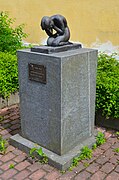- Aprés la tâche, 1904
- Äestäjä (Harrower), 1920
- Reliefs Time and Eternity, 1920
- Memorial to those fallen in the Finnish Civil War, by the Central Pori Church, 1920
- Arcum Tendit Apollo, 1924, Helsinki
- Crying Girl, 1928
- Maternal love, 1928, Helsinki[7]
art.wikisort.org - Artist
Emil Herman Robert Cedercreutz (16 May 1879 – 28 January 1949), was a Finnish Baron, sculptor and silhouette artist best known of his horse sculptures. He was a member of the Cedercreutz family.[1][2][3][4]
Emil Cedercreutz | |
|---|---|
 | |
| Born | 16 May 1879 Köyliö, Grand Duchy of Finland |
| Died | 28 January 1949 (aged 69) Harjavalta, Finland |
| Nationality | Finnish |
| Alma mater | Academy of Fine Arts, Helsinki |
| Known for | Sculptor, silhouette artist |
Life
Cedercreutz was born in the Köyliönkartano Manor and studied in the Finnish Art Society's Drawing School in Helsinki and later in Brussels 1903–1904, Rome 1904–1905 and in Académie Julian in Paris from 1906 to 1909. He was influenced by the sculptors like Charles van der Stappen, Constantin Meunier ja Auguste Rodin as well as the Tolstoyan movement.[5]

In 1914 Cedercreutz started working in his new atelier by the river Kokemäenjoki in the municipality of Harjavalta. Cedercreutz was also collecting historical artifacts from the countryside of Satakunta province.[5] 1916 he established a museum in Harjavalta, known today as the Emil Cedercreutz Museum, showing collections of Cedercreutz's work, cultural history and temporary art exhibitions.[6]
Works
References
- Lindgren, Liisa (27 January 2020). "Cedercreutz, Emil (1879 - 1949)". Kansallisbiografia. Retrieved 30 July 2020.
- Salonen, Marita (26 January 2020). "Herkkä hevosmies Emil Cedercreutz suojeli eläimiä, naisia ja homoseksuaaleja, kertoo 416-sivuinen järkäle". Kulttuuritoimitus. Retrieved 30 July 2020.
- Riikonen, Marika (7 March 2020). "Tietokirja-arvio: Hevospatsaiden tekijän kiinnostava elämä vihdoin kansissa". Hämeen Sanomat. Retrieved 30 July 2020.
- "Emil Cedercreutz kuvanveistäjänä". Harjavalta. Retrieved 30 July 2020.
- Emil Cedercreutz Biography Archived 16 July 2014 at the Wayback Machine Emil Cedercreutz Museum. Retrieved 28 August 2014.
- The Emil Cedercreutz museum Radio Uusi Jussi. Retrieved 29 August 2014.
- "Äidinrakkaus / Maternal love". Helsinki Art Museum. Retrieved 30 July 2020.
External links
- Emil Cedercreutz Foundation (in Finnish)
- Emil Cedercreutz Museum (in Finnish)
На других языках
- [en] Emil Cedercreutz
[fr] Emil Cedercreutz
Emil Herman Robert Cedercreutz (né le 16 mai 1879 à Köyliö — décédé le 28 janvier 1949 à Helsinki) est un sculpteur et silhouettiste finlandais[1].Другой контент может иметь иную лицензию. Перед использованием материалов сайта WikiSort.org внимательно изучите правила лицензирования конкретных элементов наполнения сайта.
WikiSort.org - проект по пересортировке и дополнению контента Википедии

![Äestäjä [fi] (Harrower), 1920](http://upload.wikimedia.org/wikipedia/commons/thumb/1/1c/Emil_Cedercreutz_%C3%84est%C3%A4j%C3%A4_1920.jpg/320px-Emil_Cedercreutz_%C3%84est%C3%A4j%C3%A4_1920.jpg)




![Maternal love, 1928, Helsinki[7]](http://upload.wikimedia.org/wikipedia/commons/thumb/c/c7/Varsapuistikko_2.JPG/320px-Varsapuistikko_2.JPG)